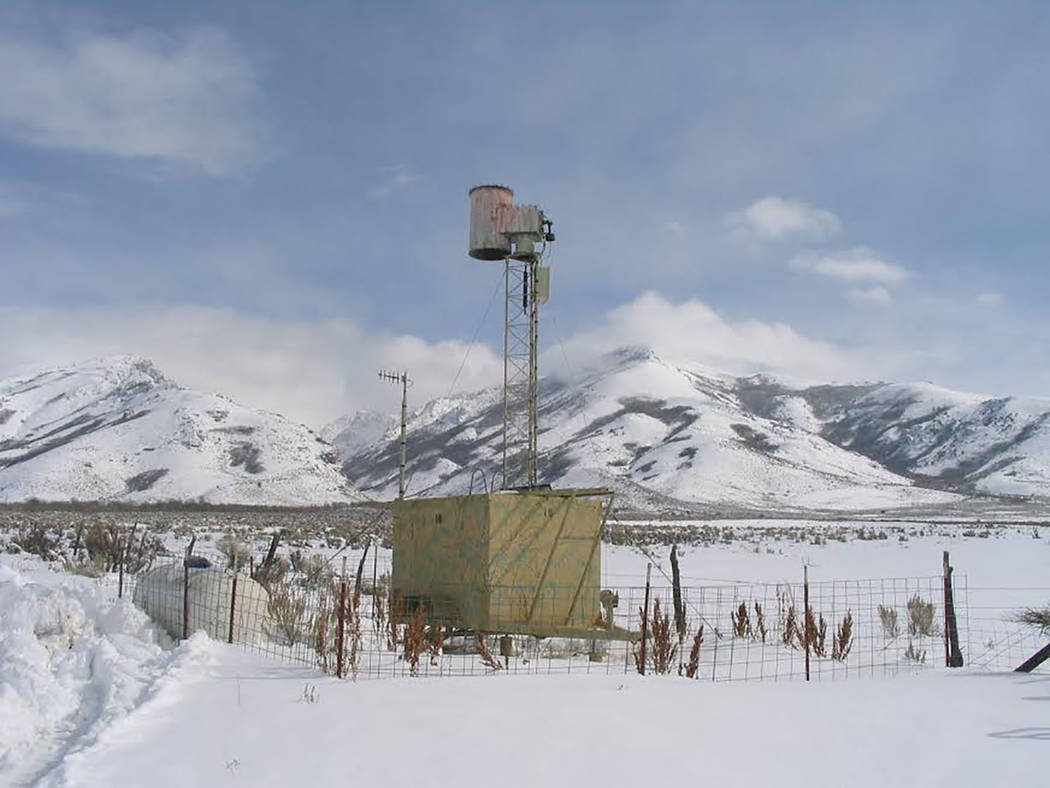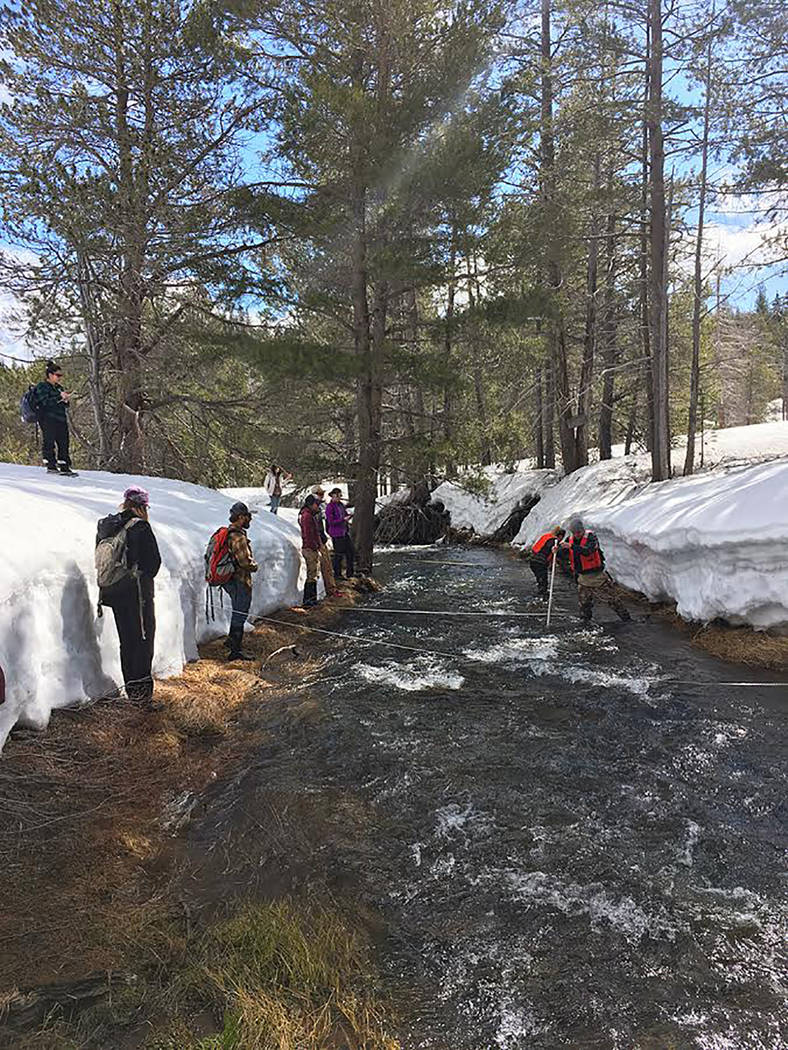Weather modification operation set for Spring Mountains
The Desert Research Institute is on the verge of initiating its newest cloud seeding operation, with the target being the Spring Mountains and the goal to increase the snowpack that in turn feeds the water supply.
Despite the possible benefits of additional water for the basins supported by the snowmelt, many Pahrump residents are opposed to the project, expressing health and environmental concerns.
As part of the process, on Sept. 4, DRI approached the Nye County Commission for a site rental agreement in order to install a remotely-controlled cloud seeding generator and weather station on land located at 7401 East Manse Road in Pahrump.
During the meeting, several of those worried by the proposal took the opportunity to air their concerns but with little effect on the outcome of the decision. DRI’s request was granted 4-1 with commissioner Donna Cox the sole voice against.
Much of the conversation on September 4 centered around the chemical to be used for the weather modification, silver iodide.
Resident Dwight Lilly said his main point of concern was the need for the chemicals to be used to be defined in the rental agreement, remarking “I am concerned about the cloud seeding, what the material they are using is… I’m not saying I am all doom and gloom about this but I think that everybody should be concerned about what’s being blown up into the air and falling back down on top of us, any crops we happen to be growing, our gardens, our livestock, my bees… I would like to see you put something in this agreement that restricts them to a material that has not been shown to cause issues with animals or people.”
Amargosa resident John Bosta added his take, citing research he had done prior to the meeting.
“There is no benchmark to determine the success of the cloud seeding,” Bosta asserted. He touched on findings that were reported in Atmospheric Research, which showed that the practice of cloud seeding with materials such as silver iodide and frozen carbon dioxide, “may not be as effective as hoped.”
However, Bosta also provided information that detailed studies that show the only known health effect of silver iodide exposure was “argyria,” a condition in which a person’s skin becomes discolored but which is otherwise not harmful. He also noted that silver iodide is not classifiable as to human carcinogenicity, according to the EPA.
Kenny Bent called the proposal “absurd” and stated, “The risk certainly outweighs any benefit.” Bent said the site itself was confusing to him, as it was not in the mountains themselves but in the valley. “The biggest problem that I see in all of this is the literature they cite in the backup here from the Weather Modification Association. If that isn’t biased, I don’t know what the heck is,” he declared.
Nye County Commissioner Dan Schinhofen interjected that the county’s duty was not to evaluate the process DRI would use.
“We do not have the expertise to decide what your process is but I am sure that your process must be overseen …” Schinhofen told the audience.
He then turned to DRI Nevada State Cloud Seeding Program Director Frank McDonough for clarification.
“It’s overseen by the state of Nevada, the division of conservation and natural resources, they oversee the project,” McDonough explained. “The cloud seeding has been conducted for nearly 60 years now. The goal of cloud seeding as will be done here is to increase snowfall. We can increase the snowfall by up to 10 to 15 percent more. We know for sure the aquifer recharge is from snowfall in the Mount Charleston area. We could probably put a foot to two feet more snow up there.”
McDonough added that silver iodide has been studied extensively and has been used in the Sierra Nevada for almost 65 years, with no negative results reported.
“When we go up and try to find the silver, compared to locations where cloud seeding has never occurred, the silver quantities are basically the same amount …” McDonough said. Silver iodide is insoluble, he added, meaning it does not get absorbed by plants or animals but remains in soil. “Silver is not necessarily toxic,” McDonough stressed. “We all have it in our teeth, this is the Silver State, whenever the wind blows there is dust containing silver blowing around, so this isn’t anything that scary.”
As to the location of the cloud-seeding equipment, McDonough agreed that placing the operation higher in the mountains would be more favorable but access to that area posed a problem, so the Manse Road location was determined to be the best option.
Using the southwest storm winds, silver iodide will be dispersed at a rate of about three-quarters of an ounce per hour and would be carried on the wind into the clouds to create snow. “We feel pretty confident that cloud seeding can be conducted from that location,” he stated, noting, “There are really no toxic effects that I am aware of.”
Regardless of the assurances offered by McDonough, many were not convinced. Pat Minshall told the commission, “Anything I have read on silver iodide disputes what has been said. It is toxic, it does get into the plants, that it is in animals as well. And I think we need to look further into this research before this is passed.”
Joe Markley agreed, stating “If it’s that fine, you will inhale it and it will stick in your lungs. If that doesn’t shorten your life up, it’d be just like smoking. If anybody really wants to look into this just look up Morgellans disease… I just think it’s the dumbest thing.”
Tom Saitta kept his comments short and to the point, telling the commission, “Leave it alone! Mother Nature is in charge. Quit messing with her.” Pricilla Lane agreed with more investigation into the process, citing health concerns and her reluctance to blindly believe whatever the government tells the people.
Tynia Dickson commented, “I would just as soon not expose my grandchildren… I can’t imagine that anything else in our air would be good. If it is snow we are trying to create, maybe we should consider creating it in the mountains where it might work out a bit better.”
Commissioner Cox was apparently as concerned as those speaking during public comment, questioning McDonough on the process before stating, “I’m reading some of your information here and it says the public science literature clearly shows no environmental health effects… Well, we don’t know that. I mean anybody can write this, anybody can publish it and call it scientific information. I don’t trust the government when they tell you it’s not going to hurt you … I don’t think we should be fooling with Mother Nature either.”
Schinhofen was not swayed by the disquiet expressed, however. “I am in support of this. I trust that you have done this enough. This could add snowpack, that adds water to our valley. I have complete faith that my grandkids are safe,” he said.
The site rental agreement passed 4-1. For more information on the rental agreement and project visit www.nyecounty.net and click on the “meeting center” link. Information pertaining to the agenda item can be found in the Sept. 4 commission meeting agenda.
Contact reporter Robin Hebrock at rhebrock@pvtimes.com



















